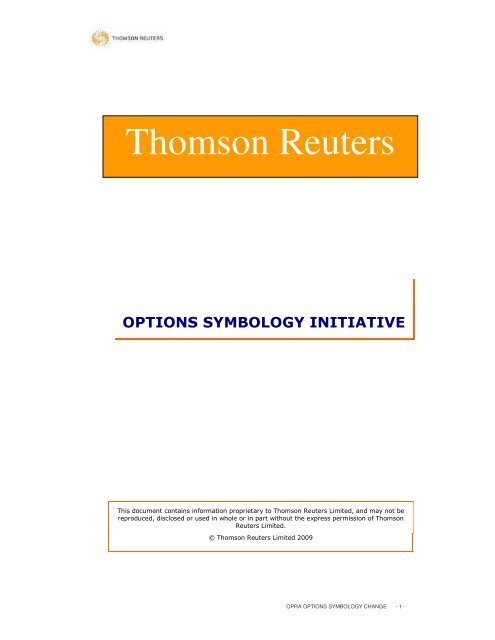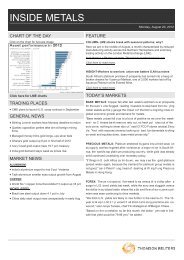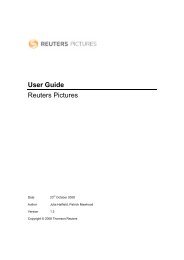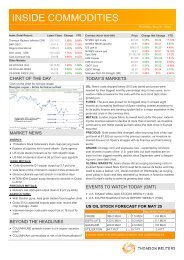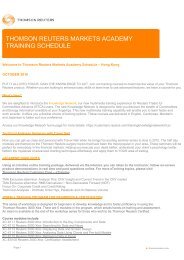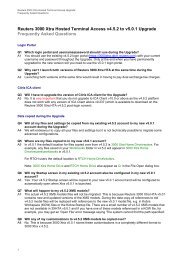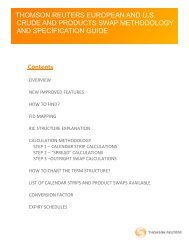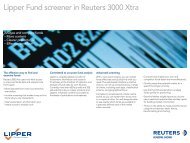Options Symbology Change - Reuters
Options Symbology Change - Reuters
Options Symbology Change - Reuters
Create successful ePaper yourself
Turn your PDF publications into a flip-book with our unique Google optimized e-Paper software.
Thomson <strong>Reuters</strong><br />
OPTIONS SYMBOLOGY INITIATIVE<br />
This document contains information proprietary to Thomson <strong>Reuters</strong> Limited, and may not be<br />
reproduced, disclosed or used in whole or in part without the express permission of Thomson<br />
<strong>Reuters</strong> Limited.<br />
© Thomson <strong>Reuters</strong> Limited 2009<br />
OPRA OPTIONS SYMBOLOGY CHANGE - 1 -
CHANGE SUMMARY<br />
Effective February 12, 2010 the <strong>Options</strong> Price Reporting Authority (OPRA) and the <strong>Options</strong><br />
Clearing Corp (OCC) will change the way they name options contracts traded on the seven<br />
US options exchanges. To accommodate those changes, Thomson <strong>Reuters</strong> will change the<br />
RICs for those options as well as the symbols used on <strong>Reuters</strong> Plus and <strong>Reuters</strong> Station.<br />
CHANGE DETAILS<br />
On December 5, 2006, the Board of Directors of the OCC approved a plan to change the<br />
symbology used in representing listed option contracts in data transmissions between market<br />
participants. The plan also calls for elimination of fractional strike prices by converting them to<br />
decimal values.<br />
The <strong>Options</strong> <strong>Symbology</strong> Initiative (OSI) has two major components:<br />
• Shift from the OPRA code as a symbol to explicitly defining options based on multiple<br />
fields - the options symbol, maturity day, call/put indicator and strike price<br />
• Replacing fractional strike prices with decimals<br />
The OCC plan defines a minimum 21-character symbol. The OPRA Technical Committee<br />
considered the OCC symbol too long for the real time data feed products it offers and decided<br />
on a somewhat shorter 17-character symbol. Both provide for using the correct exchange<br />
stock ticker symbol for the root code, an explicit strike price capable of rendering prices in<br />
pennies, explicit dates and put/call indicators. The current practice of providing multiple root<br />
symbols for a single underlying security will be largely eliminated, with some exceptions.<br />
The OPRA symbol will be 17 characters as shown below:<br />
Root<br />
Symbol<br />
5<br />
Expiration<br />
Month<br />
1<br />
Expiration<br />
Day<br />
2<br />
Expiration<br />
Year<br />
2<br />
Strike Price<br />
Denominator<br />
1<br />
Strike<br />
Price<br />
6<br />
OPRA OPTIONS SYMBOLOGY CHANGE - 2 -
The Strike Price Denominator Code field indicates the position of the floating decimal point.<br />
Denominator<br />
Code Value<br />
Whole Numerator<br />
7 Byte Price Field (number of decimal<br />
places)<br />
A 10 5 1<br />
B 100 4 2<br />
C 1,000 3 3<br />
D 10,000 2 4<br />
E 100,000 1 5<br />
The schedule calls for OPRA to implement changes in its message format by June 30, 2008<br />
but to still retain information needed by downstream users to continue to identify options using<br />
the five-letter code. Then, on February 12, 2010, both OCC and OPRA will cease supplying<br />
the information needed to maintain the five-letter code. At that point, all market participants<br />
will have to begin using symbols with explicit strike prices and dates. Over the subsequent<br />
few weeks, all root codes will be converted to match the ticker symbol of the underlying<br />
security. This will eliminate virtually all so-called “wrap” and “leap” symbols.<br />
There will be exceptions. The root symbol field in the OPRA message can accommodate a<br />
basic symbol up to four letters in length plus a single digit to designate contracts subject to<br />
corporate action adjustments for a total of five characters. Because NASDAQ symbols can be<br />
five letters or more when a subordinate issue identifier is appended, OPRA will create a<br />
separate root code to designate the subordinate issue. Other exceptions may arise and<br />
OPRA will notify market participants as needed.<br />
Thomson <strong>Reuters</strong> Implementation<br />
OPRA <strong>Options</strong> RIC Structure<br />
Thomson <strong>Reuters</strong> does not use the five-letter OPRA code for its option RICs. Instead, we use<br />
the three- or four-letter root code plus an explicit strike price and a single letter for the month<br />
and put/call indicator. Thomson <strong>Reuters</strong> will change the RIC structure to include more explicit<br />
date information. The maximum length of the new options RIC is 17 characters.<br />
Maximum length of descriptive elements in our planned RIC structure:<br />
Symbol – 5 characters (including Corporate Action)<br />
Expiration Month – Call/Put indicator – 1 digit - - Lower case expiration Month for any<br />
strike >999<br />
Expiration Day – 2 digits<br />
OPRA OPTIONS SYMBOLOGY CHANGE - 3 -
Expiration Year– 2 digits<br />
Strike Price – 5 characters – We will be using 2 decimals in our strike price unless the<br />
strike price is greater than 999.999, then we would use 1 decimal<br />
Separator and Exchange ID – 2 characters<br />
Our RIC structure will be 17 characters as shown below. Up to 15 characters will describe the<br />
option. With the period (.) separator and a single-letter exchange ID the RIC will be 17<br />
characters in total.<br />
Root<br />
Symbol<br />
Expiration<br />
Month<br />
(C/P)<br />
Expiration<br />
Day<br />
Expiration<br />
Year<br />
Strike<br />
Price<br />
Exchange<br />
ID<br />
Bytes 5 1 2 2 5 2<br />
Example MSFT1 A 17 12 05500 .U<br />
Example 1: MSFT1A170805500.U would be the NBBO RIC for the “adjusted” Microsoft<br />
$55.00 call expiring January 17, 2008. (post consolidation)<br />
Example 2: QQQQN150910000.W would be the CBOE-specific RIC for the PowerShares<br />
Trust $100.00 put expiring February 15, 2009. (post consolidation - RDFD)<br />
Chain RICs for such options would not change. They would remain 0#MSFT*.U and<br />
0#QQQQ*.W respectively. The adjusted <strong>Options</strong> on Microsoft would be under 0#MSFT1*.U.<br />
OPRA <strong>Options</strong> – OPRA Code:<br />
FID 967 (BKGD_REF) is currently being used as an illogical FID to identify the “Street<br />
Symbol” or the OPRA code. This FID will be populated with the new elongated OPRA code.<br />
Thomson <strong>Reuters</strong> needs to normalize this code to assure consistency because the <strong>Options</strong><br />
exchanges are at liberty to use denominator codes of their choice within the new OPRA<br />
format. To this extent, a “C” denominator code would be applied for all strike prices lesser<br />
than 1000 & a “B” denominator code would be used for all strike prices greater than or equal<br />
to 1000.<br />
Example 1: VIBA2211C020000 would be the OPRA Code (Pre-Consolidation) for<br />
the International Business Machine $20.00 call expiring January 22, 2011. Post<br />
Consolidation the OPRA Code would change to IBMA2211C020000.<br />
Example 2: SXGL1810B120000 would be the OPRA Code (Pre-Consolidation) for<br />
the S&P 500 Index $1200.00 call expiring December 18, 2010. Post Consolidation<br />
the OPRA Code would change to SPXL1810B120000.<br />
3000 Xtra, <strong>Reuters</strong> Data Feed (RDF)<br />
The current full quote option display includes the five-letter OPRA symbol. Thomson <strong>Reuters</strong><br />
3000 Xtra clients would have to upgrade to Display Template Version 11.3 to view the new<br />
normalized OPRA Code in its entirety. The new RIC structure is confirmed & FID 967<br />
(BKGD_REF) will contain the new normalized OPRA code.<br />
OPRA OPTIONS SYMBOLOGY CHANGE - 4 -
OPRA <strong>Options</strong> CHAIN RIC Structure:<br />
0# Chains:<br />
The 0# chain will continue to be used on the product. The RICs will be in ascending<br />
order by expiry date. Currently, the 0# is in ascending order of expiry. No change would be<br />
required.<br />
Z# Chains:<br />
The Z# chain will be continued on the product. Currently, the Z# chain provides the<br />
client with all the option chain RICs associated with the underlying security. Since “wrap” and<br />
“leap” symbols will be consolidated to the Underlying Stock as a part of the <strong>Options</strong><br />
<strong>Symbology</strong> Initiative, the Z# chain will store the Primary Option Chain & Corporate Adjusted<br />
Option chain (if necessary)<br />
<strong>Reuters</strong> Data Feed Direct (RDF-D)<br />
RDF-D will not migrate to the new RIC symbology all at once as on IDN/RDF, but will phase<br />
the introduction of the new RICs, while providing an extensive parallel run period during which<br />
both the current and new RICs will be available. The RDF-D RICs will be based explicitly on<br />
the OPRA roots and therefore the RIC changes will occur in 2 phases: The first phase will<br />
migrate to the new symbol format using the current option root codes; during the second<br />
phase, the option codes will change, based on the OCC schedule, to the consolidated symbol<br />
roots.<br />
Flex <strong>Options</strong><br />
Flex <strong>Options</strong> will continue to be supported via pages on 3000Xtra post the Option <strong>Symbology</strong><br />
Initiative as well.<br />
DataScope Equities and DataScope Select<br />
DataScope will support the new option RIC structure, and all other fields currently supported.<br />
In addition, DataScope will support the new date and year fields in their RIC. The new<br />
elongated OPRA code will be populated in the Ticker symbol field on Datascope. The new<br />
RIC structure is confirmed & the elongated OPRA code will be populated in the Ticker symbol<br />
field on Datascope<br />
OPRA OPTIONS SYMBOLOGY CHANGE - 5 -
<strong>Reuters</strong>Station, <strong>Reuters</strong> BridgeFeed<br />
Specification to REAL-TIME BDN Data <strong>Change</strong>s:<br />
BDN <strong>Symbology</strong><br />
The BDN symbology is shown in the table below.<br />
Clorg Symbol Separator Year Month<br />
• Clorg: As is standard for all BDN symbols, CLORG indicates origin (country)<br />
and symbol class (‘;’ indicating a corporate class symbol).<br />
• Symbol: 1 to 5 alphanumeric characters – should be the root option symbol<br />
* A five character root symbol is supported *provided it contains one or more<br />
digits* e.g. MSFT1. A purely alphabetic five character root symbol (e.g.<br />
CMCSA) cannot be supported as it conflicts with existing OTC handling.<br />
• Separator 1: A space between the ‘Entry’ and ‘Vehicle’ portion of corporate<br />
symbols indicates an option<br />
• Year: Two digit year of century (00-99). The year may be omitted if expiration<br />
falls within the next year (12 months). A single digit may be used if the<br />
expiration is within the next ten years.<br />
• Month: A single alphabetic character indicating month and call (A-L) or put<br />
(M-X).<br />
• Day: Two digit day of month (01-31). A single digit may be used for the first 9<br />
days of the month. The day may be omitted if it is the default expiration day of<br />
the month (the third Friday of the month).<br />
• Separator 2: A space will be used between the maturity date and strike price<br />
portions of the symbol. This is required to guarantee that the new option form<br />
can be correctly identified under all conditions.<br />
For example TORO A52<br />
Could represent an option with strike price of 52 with the year of decade<br />
omitted, or a new OCC option with a strike price of 52.0 with year, day of<br />
month and decimal point omitted<br />
• Strike Price: A floating decimal with four significant digits will be used rather<br />
than the fixed decimal position used in the OCC initiative. This will limit the<br />
accuracy supported within the strike price. This is necessary to allow the<br />
strike price to fit into the number of bits available. Trailing decimal zeros and<br />
decimal point may be omitted.<br />
If the strike price contains a decimal, for input purposes only, the second separator can be<br />
omitted. However it will be present in when displayed.<br />
Examples:<br />
C/P<br />
us;MSFT 11B15 29.75 – Call for Feb 15th 2011, strike price 29.75<br />
us;MSFT 12X17 31 – Put for Dec 17th 2012, strike price 31.0<br />
us;IBM 9A3 120.2 – Call for Jan 3rd 2009, strike price 120.2<br />
Day Separator Strike Price<br />
us; MSFT 08 A-L /M-X 18 15020<br />
3<br />
Characters<br />
Up to<br />
5 chars*<br />
Space<br />
2<br />
Characters<br />
1<br />
Character<br />
2<br />
Characters<br />
Space<br />
OPRA OPTIONS SYMBOLOGY CHANGE - 6 -<br />
5<br />
Characters
Five Character Root Symbols<br />
If options are traded off 5 character root symbols (eg: CMCSA), then on BDN the root symbol<br />
for the options will be the first four characters i.e. CMCS.<br />
If options are traded for the same company under two five character root symbols, eg:<br />
CMCSA and CMCSK, then an appropriate alternate symbol will be used to differentiate the<br />
options. For example, CMCS would be used for the most active set of options and CMCS0 for<br />
the other set.<br />
Corporate Actions<br />
Corporate actions will result in a new symbol with a trailing digit, for root symbols of up to four<br />
characters. If the original symbol already has 5 characters, then an appropriate alternate root<br />
symbol will be chosen.<br />
<strong>Reuters</strong> Plus & Thomson One<br />
Specification to <strong>Reuters</strong> Plus Data <strong>Change</strong>s:<br />
Exhibit A illustrates the new RPLUS Qsymbology. Exhibit B indicates the new Thomson<br />
format. The RPLUS and T-1 symbols will be identical in nearly all cases, the exception being<br />
for options with fractional strike prices. For fractional strike options:<br />
- The character “Y” will be used in place of the T-1 dot (“.”), to indicate the decimal position in<br />
the strike price component of the Qsymbol.<br />
- The full number of decimal positions may not be included for some options with higher strike<br />
values.<br />
Qsymbology currently uses the dot “.” character to separate the symbol root and market code<br />
extension. Use of this character elsewhere in the symbol would be problematic, and require<br />
extensive software changes. The T-1 symbol has a max size of 17 characters. The Qsymbol<br />
root has a maximum field size of 15 characters, which necessitates limiting the strike price<br />
component to 5 characters. This may require omission of a decimal digit(s) for higher priced<br />
options with fractional strike prices. Expansion of the Qsymbol root beyond 15 characters<br />
would also require extensive RPLUS software modifications. However, due to the availability<br />
of the actual strike price as a field value in the RPLUS database and broadcast, it is not<br />
essential that the symbol contain all significant digits in its strike component. Decimal digits<br />
are only required to provide a unique Qsymbol for fractional-strike options.<br />
OPRA OPTIONS SYMBOLOGY CHANGE - 7 -
Length<br />
(Mn-Mx)<br />
Exhibit A<br />
New RPLUS Option <strong>Symbology</strong> (Thomson-Based, Modified Strike)<br />
Symbol Root Exp Yr<br />
5-Char Strike (floating decimal point)<br />
QSYM<br />
(Max 15 chars)<br />
Exp<br />
Day<br />
Exp Mnth<br />
(C/P)<br />
Strike<br />
Price<br />
OPRA OPTIONS SYMBOLOGY CHANGE - 8 -<br />
.<br />
Separator<br />
1 - 5 2 2 1 1 - 5 1<br />
Format AAAA[A/c] N N A<br />
A = alpha<br />
N/n =<br />
num<br />
c = corp<br />
act digit<br />
Case<br />
R+<br />
Qsym<br />
T -1<br />
Sym<br />
- Left justified<br />
- last char can<br />
be a Corp<br />
action<br />
num[c] OR<br />
Alpha 5 th Char<br />
[A]<br />
“S” Jan 21,2009<br />
Call $60<br />
- last<br />
two<br />
digit<br />
EXAMPLE SYMBOLS<br />
1- 31<br />
“TTTT” Dec 22,2008<br />
Put $115<br />
Jan-Dec:<br />
A-L Call<br />
M-X Put<br />
n[Ynn]<br />
nn[Ynn]<br />
nnn[Yn]<br />
nnnn[Y]<br />
nnnnn<br />
(trunc if > 5ch)<br />
- Decimal<br />
fraction “[Y...]”<br />
– if req’d<br />
(see fractional<br />
strike note<br />
below * )<br />
“VV” Dec 19,2008”<br />
Call $43.33<br />
S0921A60.O TTTT0822X115.O VV10819L43Y33.O<br />
S0921A60 TTTT0822X115 VV10819L43.33<br />
Types EXAMPLE SYMBOLS<br />
Regular example SSS0921A60.O (SSS Jan 21,2009 Call $60)<br />
QEXCH<br />
Separator Market Code<br />
Ex of Strike price >100 SSSS0822X115.O (SSSS Dec 22,2008 Put $115)<br />
1-4<br />
(1 used)<br />
. A[AAA]<br />
Ex of Strike Price >1000 SSSS0822X2345.O ( SSSS Dec 22,2008 Put $2345)<br />
Corporate Action<br />
SSSS10822X16Y12.O ( SSSS1 Dec 22,2008 Put $16.125)<br />
SSSS10822X17Y5.O ( SSSS1 Dec 22,2008 Put $17.50)<br />
NBBO: “O”<br />
[Regionals:<br />
AO,XO,PO,N<br />
O,DO,QO ]
Fractional Strike Note:<br />
When we have a non-integer strike price, the Qsym will include a fractional component<br />
consisting of the letter “Y” (upper case) ** followed by up to two decimal digits, using the<br />
following scheme:<br />
Strike Price Format for Fractional Prices:<br />
Strike Price Format Note<br />
Less than 10 nYn[n] max 2 decimal positions if req’d<br />
10 – 100 nnYn[n] max 2 decimal positions if req’d<br />
100 – 999 nnnYn max 1 decimal position<br />
1000 – 9999 nnnnY “Y” only<br />
10000 and above nnnnn integer (max value 99,999)<br />
* (If > 5 digits, value truncate to 5 digits)<br />
** Decimal point indicator “Y” selected to avoid duplicating an expiration month code (A-X).<br />
Note that lower case characters are not permitted in Qsymbol. Special characters should also<br />
be avoided (dot “.” is not permitted).<br />
Length<br />
(Mn-Mx)<br />
Max 17Chars<br />
Exhibit B<br />
THOMSON T-1 Symbol (New Thomson One Option <strong>Symbology</strong>)<br />
7-Char Strike (floating decimal point)<br />
Symbol Root Exp Yr Exp Day<br />
Exp Mnth<br />
(C/P)<br />
Strike<br />
Price *<br />
1 – 5 2 2 1 1 - 7<br />
Format AAAA[A/c] N N A n[.d..]<br />
A = alpha<br />
N/n = num<br />
c = corp act<br />
digit<br />
- Left justified<br />
- last char can<br />
be a Corp action<br />
num[c] OR Alpha<br />
5 th Char [A]<br />
- last two<br />
digit<br />
Types EXAMPLE SYMBOLS<br />
1- 31<br />
Jan-Dec:<br />
A-L Call<br />
M-X Put<br />
Regular example SSS0921A60 (SSS Jan 21, 2009 Call $60)<br />
- Decimal<br />
Ex of Strike price >100 SSSS0822X10 (SSSS Dec 22,2008 Put $110)<br />
Ex of Strike price >1000<br />
fraction “.d..”<br />
SSSS0822X2340 (SSSS Dec 22,2008 Put $2,340)<br />
SSSS0822X23450 (SSSS Dec 22,2008 Put $23,450)<br />
Corporate Action SSSS10822X23.33 (SSSS1 Dec 22,2008 Put $23.33)<br />
OPRA OPTIONS SYMBOLOGY CHANGE - 9 -
Fractional Strike Note:<br />
1) All unnecessary leading/trailing 0’s removed from strike price component.<br />
2) A decimal point and trailing decimal digits added for fractional strikes if/when<br />
required.<br />
3) Assume multiple decimal digits can be included (if required) as long as max field size<br />
of 7 chars is not exceeded.<br />
OPRA OPTIONS SYMBOLOGY CHANGE - 10 -


